South Mumbai
South Mumbai[2] is the Mumbai City district which is the southernmost precinct of Greater Mumbai. It extends from Colaba to Mahim. It comprises the city's main business localities, making it the wealthiest urban precinct in India. Property prices in South Mumbai are by far the highest in India and among the highest in the world.
South Mumbai दक्षिण मुंबई | |
|---|---|
Precinct of Mumbai | |
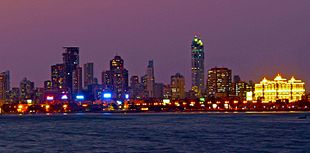 Night view of South Mumbai Skyline from the Arabian Sea | |
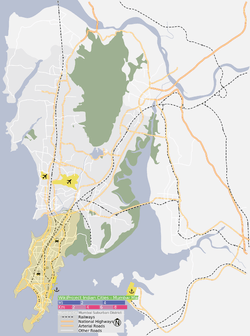 South Mumbai precinct highlighted in orange | |
 South Mumbai South Mumbai 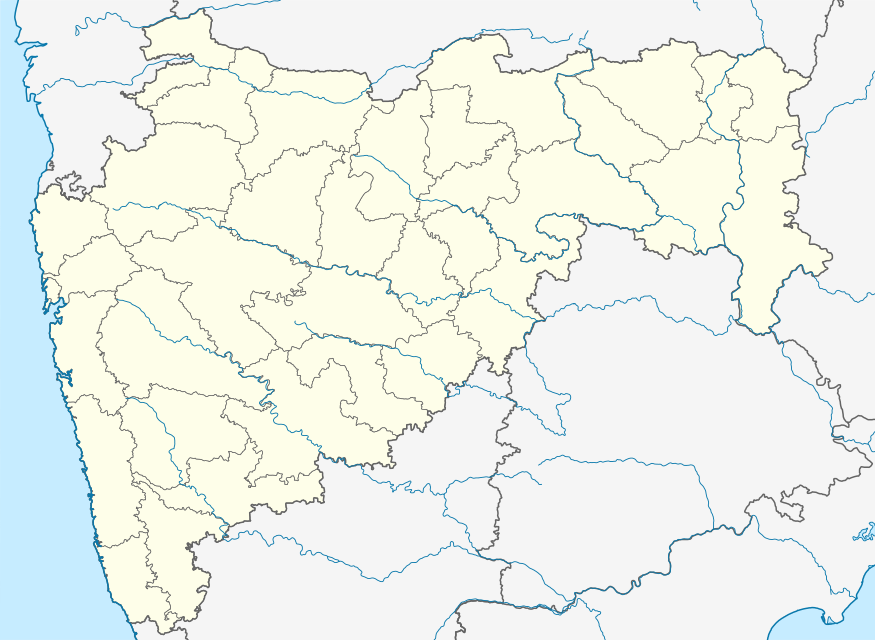 South Mumbai South Mumbai (Maharashtra) 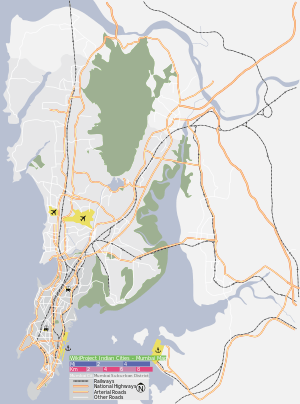 South Mumbai South Mumbai (Mumbai) | |
| Coordinates (Malabar Hill): 18.95°N 72.795°E | |
| Country | India |
| State | Maharashtra |
| District | Mumbai City |
| City | Mumbai |
| Wards | A, B, C, D, E, FS, FN, GS, GN |
| Government | |
| • Body | MCGM |
| Area | |
| • Total | 67.7 km2 (26.1 sq mi) |
| Population (2011) | |
| • Total | 3,145,966 |
| • Density | 46,000/km2 (120,000/sq mi) |
| Demonym(s) | Mumbaikar |
| Time zone | UTC+5:30 (IST) |
| South Mumbai: Population Growth | |||
|---|---|---|---|
| Census | Population | %± | |
| 1971 | 3,070,380 | — | |
| 1981 | 3,285,040 | 7.0% | |
| 1991 | 3,174,910 | −3.4% | |
| 2001 | 3,326,840 | 4.8% | |
| Est. 2011 | 3,145,966 | −5.4% | |
| Source: MMRDA[1] Data is based on Government of India Census. | |||
.jpg)
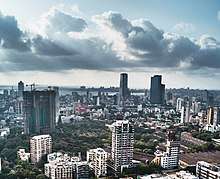
Notably Cumballa Hill, Cuffe Parade, Malabar Hill, Breach Candy, Altamount Road-Kemps Corner as well as some parts of Worli are constantly ranked in the Global Property Index.
Billionaire Mukesh Ambani's $1.5 billion home Antilia is located here and is now a part of the iconic skyline. Most residents of South Mumbai belong to old money business, law, trade and fashion families. Geographically, South Mumbai lies at the southern corner of Salsette Island. Most city residents use the term to refer to the stretch extending from Colaba to Mahim and Sion as South Mumbai. The area is delimited on the east by Mumbai harbour and on the west by the Arabian Sea.
South Mumbai is also home to the most prestigious schools; namely The Cathedral & John Connon School, JB Petit, Campion, Bombay International, St Mary's I.C.S.E. etc. ; the most exclusive sports clubs: CCI, The Willingdon Sports Club as well as Bombay Gymkhana and the most expensive hospitals: Breach Candy Hospital, Bombay Hospital, Jaslok Hospital and Hurkisondas Hospital; in the nation.
Significance
South Mumbai hosts the Reserve Bank of India, Bombay Stock Exchange and one of the oldest YMCA buildings. Its primary business districts are the Fort, Nariman Point, Ballard Estate and more recently Lower Parel, Mumbai Central. Many leading Indian and multi-national companies are headquartered here. Chhatrapati Shivaji Maharaj Terminus (CSTM) and Churchgate serve as headquarters and starting point for country's Central Railway and Western Railway lines respectively.
The headquarters of the Brihanmumbai Municipal Corporation, the governing civic body of Greater Mumbai is located in South Mumbai. The Bombay High Court is also in South Mumbai.
The area houses a significant proportion of prime upmarket residential neighbourhoods of Mumbai including: Pedder Road, Nepean Sea Road, Kemps Corner, Altamount Road, Carmichael Road, Breach Candy and Walkeshwar Road, forming a sort of golden quadrilateral and includes some of the most expensive residential areas in the world, such as the Hanging Gardens, Kemps Corner, Cuffe Parade and Malabar Hill.
South Mumbai is home to two UNESCO World Heritage Sites: Chhatrapati Shivaji Maharaj Terminus and the city's distinctive ensemble of Victorian and Art Deco buildings. South Mumbai's architecture comprises many Victorian, Gothic, Art Deco style buildings, structures and historical monuments from the colonial era which attract tourists throughout the year.
South Mumbai has reputed and leading educational institutions such as Jamnalal Bajaj Institute of Management Studies, St. Xavier's College, Government Law College, Jai Hind College, Wilson College, Grant Medical College, Sydenham Institute of Management Studies, Research and Entrepreneurship Education to name a few.
Many distinctive sporting clubs have been an integral part of South Mumbai landscape like the Willingdon Sports Club, the Turf Club at Mahalaxmi Racecourse, the Bombay Gymkhana, the Breach Candy Club, the N.S.C.I, and the Malabar Hill Club (Formerly W.I.A.A Club). The Cricket Club of India (CCI) and Mumbai Cricket Association (MCA) are located at Mumbai's two cricket stadiums, namely Brabourne Stadium and Wankhede Stadium respectively.
Although land reclamation has allowed the southernmost tip of the district to double in size since the 1970s, the business districts face an acute shortage of real estate. As a result, the real-estate prices are among the top ten worldwide. As a ratio to average per capita income, real-estate prices in the business districts remain the most expensive in the world.
South Mumbai is also the home to several of the city's sporting grounds, including Brabourne Stadium, Wankhede Stadium, Shivaji Park, Azad Maidan, Oval Maidan and Cooperage Ground.
Mumbai's most popular beach, Girgaon Chowpatty is located at the beginning of a 3.6 km esplanade known as the Marine Drive which is a popular hangout spot among the citizens. Another popular esplanade in South Mumbai is the Worli Seaface.
South Mumbai also has popular art galleries and museums like Chhatrapati Shivaji Maharaj Vastu Sangrahalaya, Jehangir Art Gallery, Nehru Centre Art Gallery.
Ethnically, South Mumbai continues to be dominated by the diverse communities of the ethnic population.
South Mumbai has become less congested with the creation of the Bandra Worli Sea Link. Auto rickshaws are strictly banned here. This facilitates quicker transport between people residing in the suburbs and the corporate offices in South Mumbai. Traffic is a major concern in most parts. South Mumbai is one of India's most diverse areas since it contains a variety of eating options from 5-star hotels to street food. Being connected to the coast has also made it a very important port for business.
Division
The city of Mumbai lies on Salsette Island. Administratively it has two official divisions: Mumbai City district and Mumbai Suburban district. Mumbai City district consists of the Southern part of Salsette Island - the area is called South Mumbai. Mumbai Suburban district consists the Western, Eastern, Central and Northern parts of the city.
The Northernmost portion of the island - outside Mumbai city limits - lies in Thane district.
Old Bombay
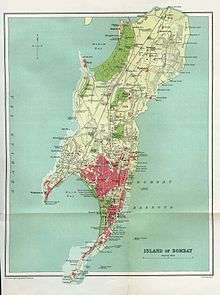
Old Bombay was used to refer to the area which was formed by the merging of the seven original islands of Mumbai, India. The term was used from the 19th century until the 1980s and is now considered archaic, however still widely used.
Notes
- "Population and Employment profile of Mumbai Metropolitan Region" (PDF). Mumbai Metropolitan Region Development Authority (MMRDA). Archived from the original (PDF) on 28 December 2009. Retrieved 4 June 2010.
References
External links
| Wikivoyage has a travel guide for South Mumbai. |
| Wikimedia Commons has media related to South Mumbai. |